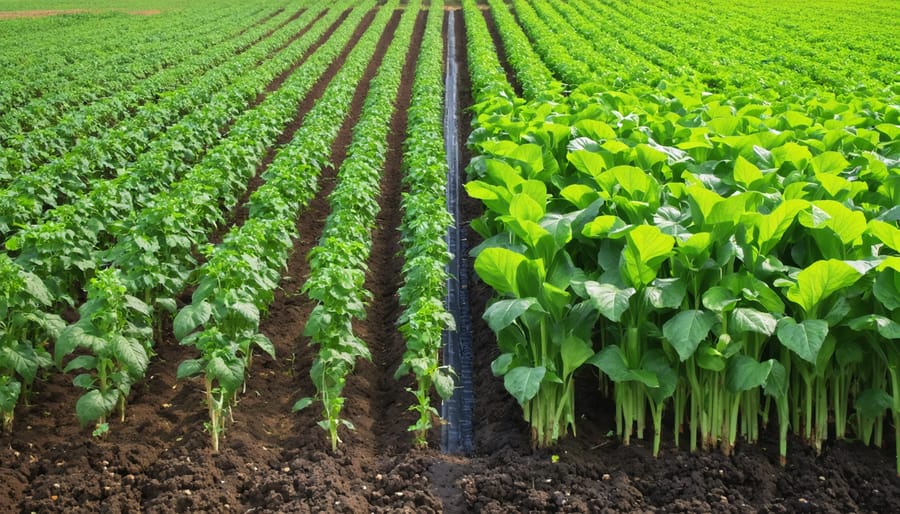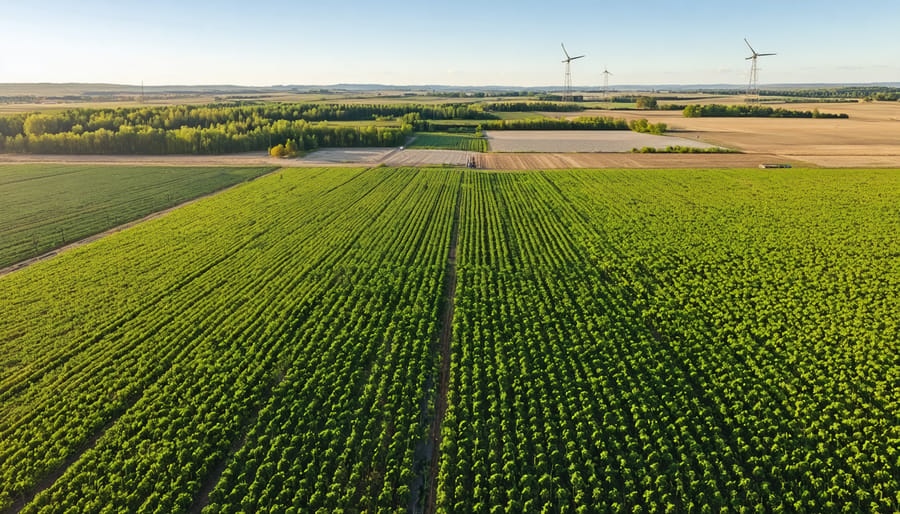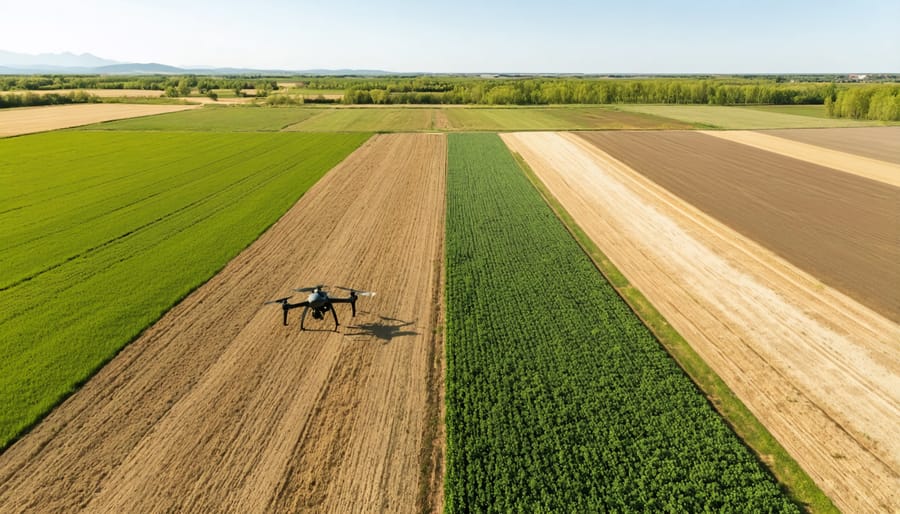Slash pesticide costs by up to 60% while boosting crop yields through Integrated Pest Management (IPM) – a proven system that’s transforming Canadian agriculture. From Medicine Hat to Peace River, Alberta farmers implementing IPM report stronger pest resistance, healthier soil biology, and increased profitability. Our research with local agronomists and natural pest control success stories demonstrate how strategic pest monitoring, biological controls, and habitat manipulation create resilient farming systems. By integrating traditional knowledge with cutting-edge monitoring technology, IPM delivers immediate economic benefits while building long-term environmental sustainability. This systematic approach not only protects crops but also preserves beneficial insects, reduces chemical resistance, and maintains ecological balance – making it the cornerstone of modern sustainable agriculture in Canada’s prairies.
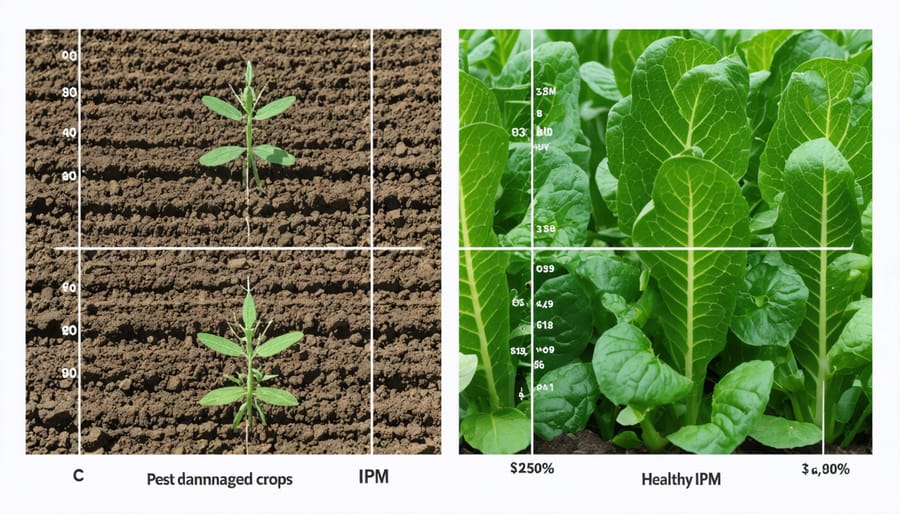
The Economic Power of IPM in Alberta Farms
Cost Savings Through Prevention
Implementing IPM practices can lead to significant cost savings for Alberta farmers through reduced pesticide usage and more efficient labor allocation. Local studies show that farms employing IPM strategies typically reduce their pesticide applications by 50-70% within the first two years, resulting in average savings of $40-60 per hectare on chemical costs alone.
Beyond immediate pesticide savings, IPM’s preventative approach minimizes the need for emergency pest control measures, which often require expensive rush treatments and additional labor hours. For instance, regular monitoring and early detection of wheat midge in central Alberta has helped farmers save approximately $75 per hectare by avoiding crisis-level infestations.
Labor costs also decrease as workers spend less time on reactive pest control and more on strategic prevention. The Prairie Agricultural Machinery Institute reports that farms using IPM reduce their pest-related labor hours by roughly 30% after the initial implementation phase. While setting up an IPM system requires upfront investment in training and monitoring equipment, most Alberta farmers report breaking even within 12-18 months, with increasing returns in subsequent years through reduced input costs and improved crop quality.
Higher Crop Quality and Market Value
Implementing IPM practices consistently leads to superior crop quality, directly impacting your bottom line through better market opportunities. Alberta farmers using IPM report fewer pest-damaged crops and reduced chemical residues, resulting in produce that meets or exceeds premium market standards.
For example, local canola producers using IPM strategies have seen up to 15% improvement in seed quality, leading to better grades and higher returns at market. Similarly, potato farmers in southern Alberta have reported fewer defects and improved storage life, allowing them to command premium prices from processors and retailers.
The reduction in pesticide use through IPM also helps meet increasingly strict export requirements and organic certification standards. This opens doors to specialty markets and value-added opportunities, particularly in health-conscious consumer segments willing to pay more for sustainably produced foods.
Many Alberta grain producers have successfully leveraged their IPM practices to access premium markets in Asia and Europe, where buyers specifically seek products with minimal chemical inputs. These market advantages, combined with reduced input costs, make IPM a powerful tool for improving farm profitability while maintaining high product quality.
Environmental Benefits That Matter to Alberta
Soil Health Enhancement
One of the most significant advantages of Integrated Pest Management is its ability to improve soil health and maintain robust soil ecosystems. When farmers in Alberta reduce their reliance on chemical pesticides, beneficial soil organisms like earthworms, fungi, and bacteria can thrive. These organisms play crucial roles in breaking down organic matter, cycling nutrients, and creating stable soil structures.
IPM practices such as crop rotation and cover cropping contribute to enhanced soil biodiversity. For instance, Prairie farmers who implement diverse rotation schedules report improved soil structure and increased organic matter content within just a few growing seasons. The introduction of beneficial insects and microorganisms through IPM methods helps create a balanced soil food web that naturally suppresses harmful pests and pathogens.
Many Alberta producers have noticed that their fields managed under IPM principles show better water retention and reduced erosion. The improved soil structure leads to better root development and nutrient uptake by crops. Local research at the University of Alberta demonstrates that fields managed with IPM techniques typically show 15-20% higher levels of soil organic matter compared to conventionally managed fields.
By focusing on biological pest control methods and reducing synthetic inputs, IPM helps maintain the delicate balance of soil microorganisms that are essential for long-term soil fertility and crop health.
Water Conservation Success Stories
The Jenkins family farm in Lethbridge has reduced their water consumption by 40% since implementing IPM strategies three years ago. By carefully monitoring soil moisture levels and pest populations, they’ve optimized their irrigation scheduling while maintaining crop health. Their success stems from using pest-resistant varieties and enhancing beneficial insect populations, which reduced the need for water-intensive chemical treatments.
In the Red Deer region, the Morrison Agricultural Cooperative achieved remarkable results through their IPM water conservation program. Their approach combines soil moisture sensors with regular pest scouting, resulting in a 30% reduction in irrigation needs across 2,000 hectares of mixed cropland. The cooperative’s members report that better pest management has led to stronger root systems, improving their crops’ water uptake efficiency.
The Bow River Irrigation District’s 2022 study demonstrated that farms using IPM practices averaged 25% less water usage compared to conventional methods. Local farmer Sarah Thompson shares, “Since adopting IPM, we’ve cut our water use by nearly a third. The key was understanding how pest management and water conservation work together. We now time our irrigation to discourage pest-friendly conditions while maintaining optimal soil moisture.”
These success stories highlight how IPM not only protects crops but also contributes significantly to water conservation efforts, making it an invaluable approach for sustainable farming in Alberta’s semi-arid climate.
Building Natural Pest Resistance
Beneficial Insect Management
Creating a thriving environment for beneficial insects for pest control is essential for successful IPM implementation. Here in Alberta, we’ve seen remarkable success with farmers who maintain diverse field margins and shelter belts to support beneficial insect populations.
Start by planting native flowering species like yarrow, golden rod, and asters around your fields. These plants provide nectar and pollen throughout the growing season, attracting ladybugs, parasitic wasps, and ground beetles that naturally control pest populations. Consider establishing beetle banks – raised strips of native grasses that offer overwintering habitat for predatory beetles.
Minimize broad-spectrum insecticide use, as these products can harm beneficial insects along with pests. Instead, use selective treatments when necessary, and time applications to avoid peak beneficial insect activity. Many Alberta farmers have found success with trap crops – sacrificial plantings that draw pests away from main crops while providing habitat for their natural enemies.
Regular monitoring helps track beneficial insect populations. Simple techniques like sweep netting and visual inspections can help you assess the effectiveness of your habitat management strategies. Remember, establishing strong beneficial insect populations takes time, but the long-term benefits to your operation make it worthwhile.
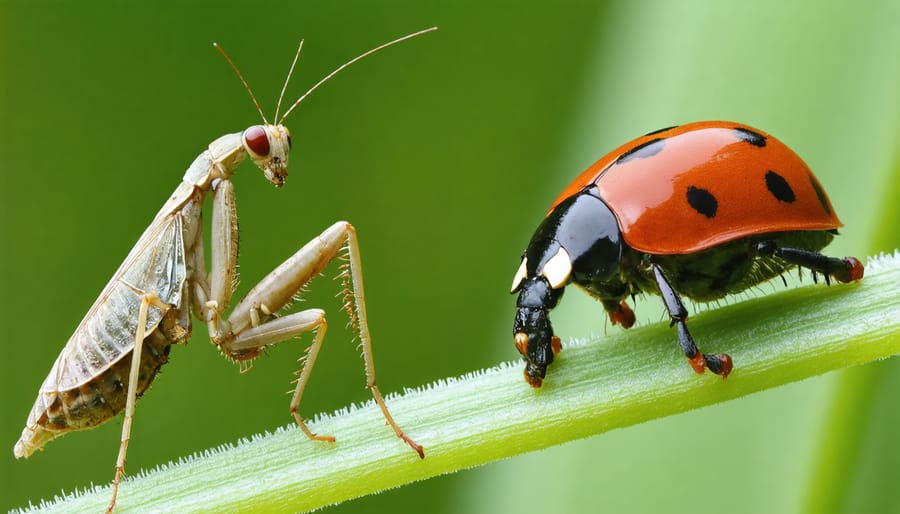
Crop Rotation Strategies
Crop rotation serves as a cornerstone of effective integrated pest management in Alberta’s farming systems. By strategically changing crops each season, farmers can significantly disrupt pest life cycles and reduce population buildups. A well-planned three to four-year rotation pattern has shown remarkable success in controlling persistent pests like wheat midge and root maggots.
For optimal results, Alberta farmers typically rotate between cereals, oilseeds, and pulse crops. For instance, following canola with wheat, then field peas, and back to wheat helps break disease cycles while maintaining soil health. This approach has helped many local farmers reduce pesticide use by up to 40% while maintaining yields.
Southern Alberta farmer Mike Thompson shares, “Since implementing a diverse rotation schedule five years ago, we’ve seen a dramatic decrease in flea beetle pressure in our canola fields, and our soil structure has improved significantly.”
Consider these proven rotation combinations:
– Wheat → Canola → Field Peas → Barley
– Canola → Wheat → Lentils → Oats
– Barley → Soybeans → Wheat → Fallow
Remember to account for your specific soil conditions and local pest pressures when planning rotations. Working with neighboring farms to coordinate rotation patterns can enhance regional pest management effectiveness and create broader ecological benefits for the farming community.
Simple Steps to Start IPM Today

Monitoring and Assessment Tools
Effective pest management starts with reliable monitoring tools that help farmers make informed decisions. In Alberta’s diverse agricultural landscape, modern monitoring techniques have revolutionized how we track and assess pest populations.
Essential monitoring tools include yellow sticky traps for flying insects, pheromone traps for specific pest species, and soil sampling equipment for root-feeding pests. Many Alberta farmers now use digital pest mapping systems and weather monitoring stations to predict pest outbreaks and optimize treatment timing.
Regular field scouting remains crucial, with recommended weekly inspections during critical growth stages. Simple tools like sweep nets, beating sheets, and magnifying glasses help identify both pest and beneficial insects. Establishing monitoring stations across your fields at 50-metre intervals provides reliable data for decision-making.
Documentation is equally important. Digital apps and traditional field notebooks help track pest populations, beneficial insects, and weather conditions over time. This historical data proves invaluable for predicting future pest patterns and evaluating management strategies.
Temperature and moisture sensors, coupled with growing degree day calculators, enable farmers to anticipate pest emergence and development stages. These tools, when used consistently, form the foundation of successful IPM programs and help reduce unnecessary pesticide applications while maximizing crop protection.
Creating Your IPM Action Plan
Developing an effective IPM strategy starts with a thorough assessment of your farm’s specific needs. Begin by mapping your fields and documenting past pest issues, including types of pests, severity, and seasonal patterns. This historical data will form the foundation of your customized approach.
Next, establish your monitoring protocol. Set up regular field scouting schedules, typically weekly during peak growing seasons, and create detailed record-keeping systems. Consider using digital tools or apps designed for Alberta farmers to track pest populations and weather patterns.
Determine your action thresholds – the point at which pest control measures become economically justified. Work with local agricultural extension offices to understand regional threshold guidelines and adjust them based on your crop value and management costs.
Build your pest control toolkit by incorporating multiple control methods:
– Cultural controls: Crop rotation, resistant varieties, and adjusted planting dates
– Physical controls: Traps, barriers, and mechanical cultivation
– Biological controls: Beneficial insects and natural predators
– Chemical controls: Used only when necessary and selected for minimal environmental impact
Create an implementation timeline that aligns with your growing season. Include specific tasks, responsible team members, and equipment needs. Remember to factor in Alberta’s unique climate patterns and growing conditions when planning control measures.
Finally, develop an evaluation system to assess your IPM program’s effectiveness. Track pest populations, crop damage levels, and control costs throughout the season. Use this information to refine your approach for the following year.
Integrated pest management represents a cornerstone of sustainable agriculture in Canada, offering a comprehensive approach that benefits both farmers and the environment. The evidence is clear: IPM programs reduce pesticide costs by up to 50%, improve crop quality, and help maintain ecological balance across Alberta’s diverse agricultural landscape.
By implementing IPM strategies, you’re not just protecting your crops – you’re investing in the long-term health of your land and the sustainability of your farming operation. The combination of biological controls, cultural practices, and targeted chemical applications creates a robust defense system that adapts to changing pest pressures and environmental conditions.
As our agricultural community faces increasing challenges from climate change and evolving pest resistance, IPM provides a flexible framework that grows with your needs. The time to act is now. Start by assessing your current pest management practices and gradually incorporate IPM principles into your operation. Connect with local agricultural extension services and fellow farmers who have successfully implemented IPM programs.
Remember, every step toward integrated pest management is a step toward more resilient and profitable farming. Your choice to embrace IPM today helps secure a sustainable agricultural future for generations to come.

